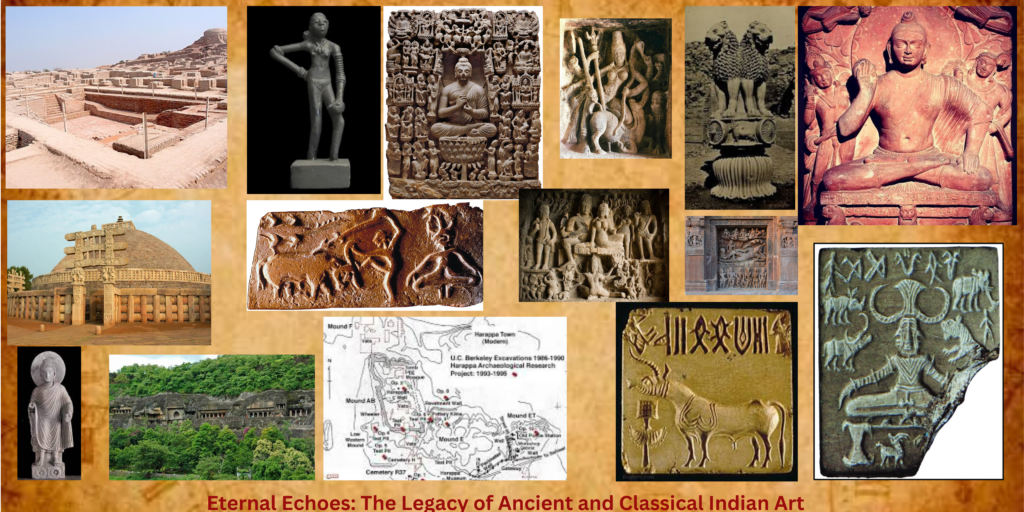
Indian Art: A Kaleidoscope of Culture and History
Indian art’s ancient and classical periods are marked by a profound evolution of techniques, styles, and themes, reflecting the socio-religious context of the times. This era, stretching from the Indus Valley civilization to the Gupta period, laid the foundational aesthetics and iconography that would influence Indian art for centuries.
Indus Valley Civilization (c. 3300–1300 BCE)
- Urban Planning and Architecture: The Indus Valley cities, such as Mohenjo-Daro and Harappa, showcase advanced urban planning with grid layouts, drainage systems, and brick houses. The Great Bath of Mohenjo-Daro is an early example of sophisticated public architecture.
- Sculptures and Seals: The civilization is renowned for its small but intricately carved terracotta figurines, often depicting animals, deities, and everyday life. The Dancing Girl, a bronze statue, exemplifies the artistic skill in metalwork.
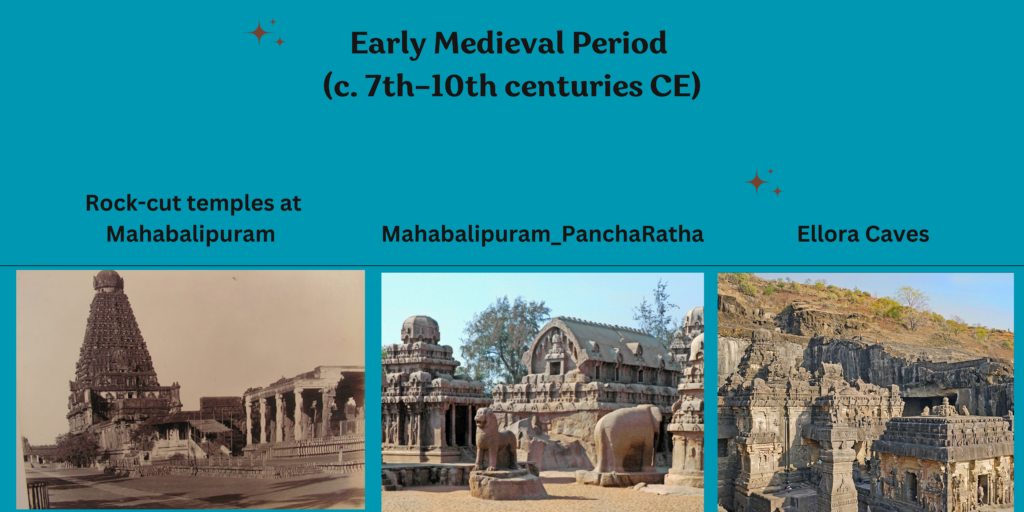
Maurya Period (c. 322–185 BCE)
- Ashokan Pillars: Emperor Ashoka’s reign saw the erection of stone pillars across his empire, inscribed with edicts promoting Dharma (moral law). The most famous is the Lion Capital of Ashoka at Sarnath, now India’s national emblem, which combines realistic animal sculptures with symbolic elements.
- Stupas and Cave Temples: The construction of stupas, such as the Great Stupa at Sanchi, began during this period. These hemispherical structures enshrine relics and are adorned with carved gateways (toranas) illustrating Buddhist narratives. The Barabar Caves, with their polished rock-cut interiors, are among the earliest examples of Buddhist monastic architecture.
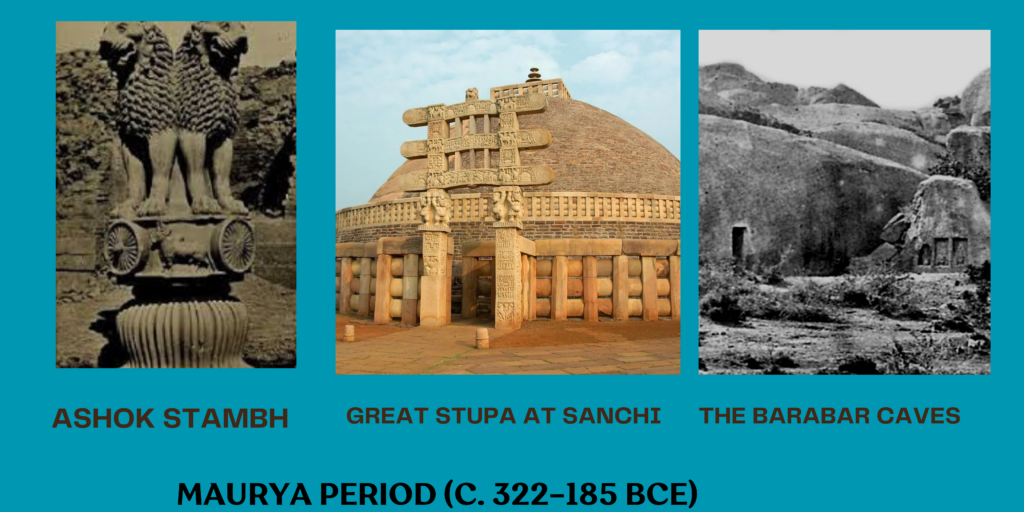
Kushan Period (c. 1st–3rd centuries CE)
- Gandhara and Mathura Schools of Art: The Kushan Empire fostered two distinct art styles. The Gandhara school, influenced by Greco-Roman art, is characterized by realistic human figures, draped garments, and curly hair. The Mathura school, on the other hand, developed a more indigenous style with robust, sensuous forms and elaborate drapery. Both schools contributed significantly to the iconography of the Buddha.
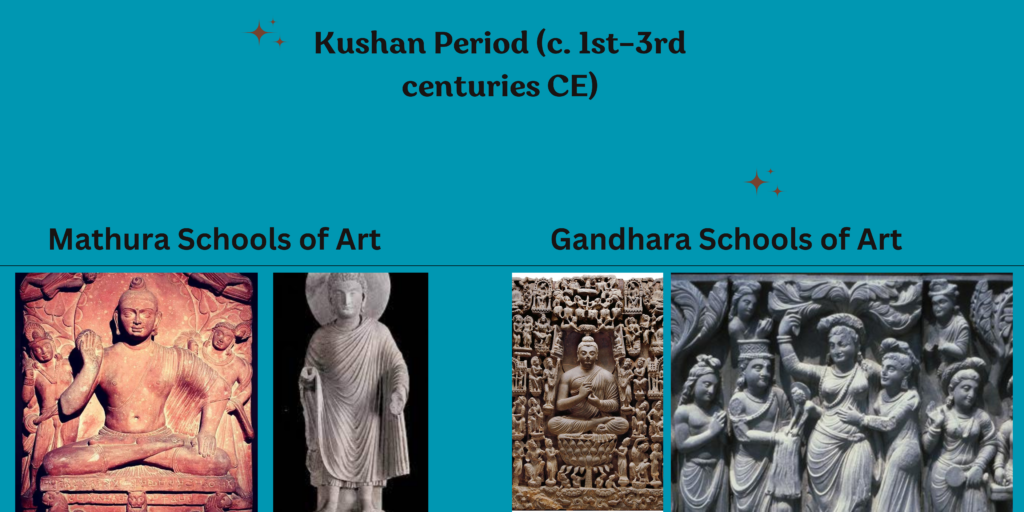
Gupta Period (c. 4th–6th centuries CE)
- Golden Age of Indian Art: The Gupta period is considered the zenith of classical Indian art, where aesthetics and spirituality blended seamlessly.
- Sculpture: Gupta sculptures are renowned for their grace, poise, and refined execution. The Sarnath Buddha, with its serene expression and intricate halo, epitomizes Gupta artistry. The sculptures from this period often depict deities like Vishnu, Shiva, and Durga, embodying idealized human forms with fluid lines and naturalistic details.
- Cave Paintings: The Ajanta Caves, a UNESCO World Heritage site, house magnificent frescoes that depict the Jataka tales (stories of the Buddha’s previous lives). These murals are celebrated for their vibrant colors, intricate patterns, and dynamic compositions, providing a window into the life and culture of the time.
- Temple Architecture: The Gupta era saw the beginning of structural temples built from stone and brick. The Dashavatara Temple in Deogarh is a prime example, featuring intricate carvings and a well-planned layout. This period also marked the emergence of the shikhara (spire), which would become a defining feature of North Indian temples.
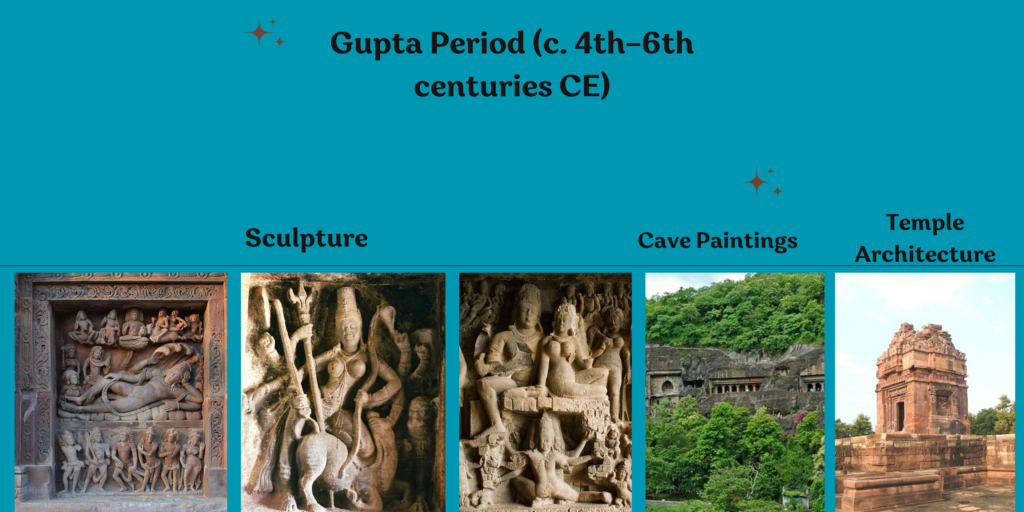
Early Medieval Period (c. 7th–10th centuries CE)
- South Indian Temple Architecture: The Pallavas and Cholas in the south developed distinct monolithic rathas (chariots) and intricate bas-reliefs, are Pallava masterpieces. The Chola dynasty’s architectural styles. The rock-cut temples at Mahabalipuram, with their Brihadeeswara Temple at Thanjavur is a monumental example of Dravidian architecture, renowned for its towering vimana (temple tower) and exquisite bronzes.
- Ellora Caves: Spanning the 5th to 10th centuries, the Ellora Caves in Maharashtra are a testament to religious harmony, featuring Hindu, Buddhist, and Jain rock-cut temples and monasteries. The Kailasa temple, a massive monolithic structure dedicated to Shiva, is an architectural marvel.
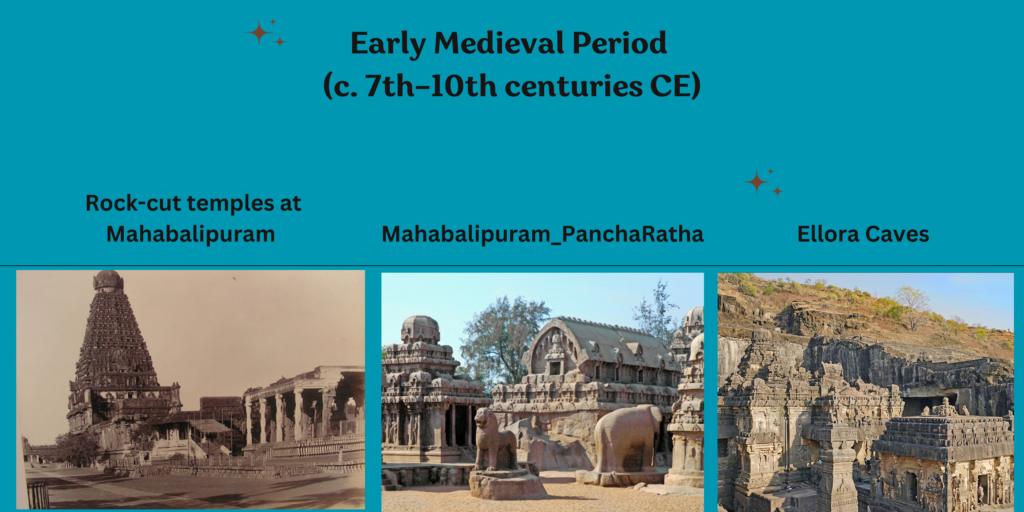
Key Themes and Techniques
- Religious and Mythological Narratives: Much of ancient and classical Indian art is centered around religious and mythological themes, reflecting the spiritual ethos of the times. Depictions of deities, legends, and cosmic events are common.
- Symbolism and Iconography: Indian art from this period is rich in symbolism. For example, the lotus, often seen in sculptures and paintings, symbolizes purity and divine beauty. Iconographic conventions, such as the mudras (hand gestures) of the Buddha, convey specific meanings and spiritual messages.
- Techniques and Materials: Artists employed a variety of materials, including stone, bronze, terracotta, and pigments derived from natural sources. Techniques like lost-wax casting for bronzes, intricate stone carving, and fresco painting demonstrate the high level of craftsmanship.
Conclusion
These eras not only produced some of the most iconic works of art but also laid the groundwork for future artistic developments
